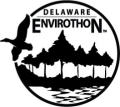Using a field guide to birds, identify two raptor species and determine their habitat requirements Do the same for two waterfowl species and two passerine species.
Choose a large mammal and track its food chain down to its lowest possible component.
List the animals likely to be found in a mature forest type.
Name three furbearers found in your area of Delaware. Determine whether there is an open trapping season on them. Check the current hunting regulations. List the maximum number of deer legally allowed by one person in Delaware.
Go to the woodlot nearest your school and list four habitat types found there.
Observe a wetland and discuss the variety of activity visible or likely to be taking place in that area.
Sample Wildlife Questions
1. Name five key components of a wildlife habitat.
2. What is an ecotone?
3. A healthy wetland has a vegetative buffer around the surrounding edges. List two reasons why a buffer is both helpful and necessary for a healthy wetland.
4. Vernal pools provide good habitats for many salamander and frog species to lay eggs and for their young to develop. Why is this?
5. List 5 stages of plant succession.
6. List three characteristics of an invasive plant.
7. Identify the differences between species that are native, non-native, nuisance and invasive.
8. What is a “limiting factor” in an ecosystem?
9. What is the difference between social/cultural carrying capacity and biological carrying capacity?
10. Describe the user-pay/user-benefits model used by the Wildlife Restoration Act to support wildlife and habitat restoration and conservation.
11. What are two diseases currently affecting white-tailed deer in Delaware?
12. What is a “best management practice”?
